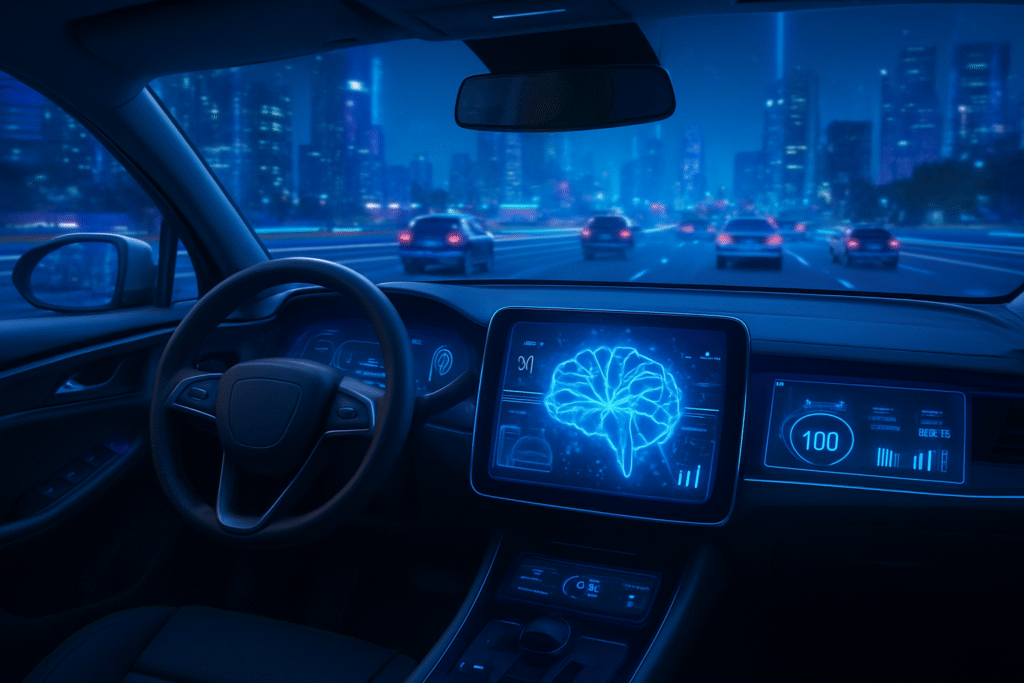
The automotive industry is in the midst of an unprecedented technological upheaval, as the traditional mechanical beast transforms into a sophisticated, software-defined machine powered by artificial intelligence (AI). As of late 2025, a confluence of advancements in AI, Advanced Driver-Assistance Systems (ADAS), and connected vehicle technologies is fueling an insatiable demand for semiconductors, fundamentally reshaping vehicle architectures and paving the way for a new era of mobility. This shift is not merely incremental but a foundational change, promising enhanced safety, unparalleled personalization, and entirely new economic models within the transportation sector.
The immediate significance of this transformation is palpable across the industry. Vehicle functionality is increasingly dictated by complex software rather than static hardware, leading to a robust automotive semiconductor market projected to exceed $85 billion in 2025. This surge is driven by the proliferation of high-performance processors, memory, and specialized AI accelerators required to manage the deluge of data generated by modern vehicles. From autonomous driving capabilities to predictive maintenance to hyper-personalized in-cabin experiences, AI is the central nervous system of the contemporary automobile, demanding ever more powerful and efficient computing solutions.
The Silicon Brain: Unpacking the Technical Core of Automotive AI
The architectural shift in automotive computing is moving decisively from a multitude of distributed Electronic Control Units (ECUs) to centralized, high-performance computing (HPC) platforms and zonal architectures. This change is driven by the need for greater processing power, reduced complexity, and the ability to implement over-the-air (OTA) software updates.
Leading semiconductor giants are at the forefront of this evolution, developing highly specialized Systems-on-Chips (SoCs) and platforms. NVIDIA (NASDAQ: NVDA) is a key player with its DRIVE Thor superchip, slated for 2025 vehicle models. Thor consolidates automated driving, parking, driver monitoring, and infotainment onto a single chip, boasting up to 1000 Sparse INT8 TOPS and integrating an inference transformer engine for accelerating complex deep neural networks. Its configurable power consumption and ability to connect two SoCs via NVLink-C2C technology highlight its scalability and power.
Similarly, Qualcomm (NASDAQ: QCOM) introduced its Snapdragon Ride Flex SoC family at CES 2023, designed to handle mixed-criticality workloads for digital cockpits, ADAS, and autonomous driving on a single hardware platform. Built on a 4nm process, it features a dedicated ASIL-D safety island and supports multiple operating systems through isolated virtual machines, offering scalable performance from 50 TOPS to a future capability of 2000 TOPS.
Intel's (NASDAQ: INTC) Mobileye continues to innovate with its EyeQ6 family, with the EyeQ6L (Lite) targeting entry-to-premium ADAS and the EyeQ6H (High) for premium ADAS (Level 2+) and partial autonomous vehicle capabilities. Both are manufactured on a 7nm process, with the EyeQ6H delivering compute power equivalent to two EyeQ5 SoCs. Intel also unveiled a 2nd-generation AI-enhanced SDV SoC at Auto Shanghai in April 2025, featuring a multi-process node chiplet architecture projected to offer up to a 10x increase in AI performance for generative and multimodal AI.
This technical evolution marks a significant departure from previous approaches. The traditional distributed ECU model, with dozens of separate controllers, led to wiring complexity, increased weight, and limited scalability. Centralized computing, exemplified by NVIDIA's Thor or Tesla's (NASDAQ: TSLA) early Autopilot hardware, consolidates processing. Zonal architectures, adopted by Volkswagen's Scalable Systems Platform (SSP) and GM's Ultifi, bridge the gap by organizing ECUs based on physical location, reducing wiring and enabling faster OTA updates. These architectures are foundational for the Software-Defined Vehicle (SDV), where features are primarily software-driven and continuously upgradeable. The AI research community and industry experts largely view these shifts with excitement, acknowledging the necessity of powerful, centralized platforms to meet the demands of advanced AI. However, concerns regarding the complexity of ensuring safety, managing vast data streams, and mitigating cybersecurity risks in these highly integrated systems remain prominent.
Corporate Crossroads: Navigating the AI Automotive Landscape
The rapid evolution of automotive computing is creating both immense opportunities and significant competitive pressures for AI companies, tech giants, and startups. The transition to software-defined vehicles (SDVs) means intelligence is increasingly a software domain, powered by cloud connectivity, edge computing, and real-time data analytics.
AI semiconductor companies are clear beneficiaries. NVIDIA (NASDAQ: NVDA) has solidified its position as a leader, offering a full-stack "cloud-to-car" platform that includes its DRIVE hardware and DriveOS software. Its automotive revenue surged 72% year-over-year in Q1 FY 2026, targeting $5 billion for the full fiscal year, with major OEMs like Toyota, General Motors (NYSE: GM), Volvo (OTC: VOLVY), Mercedes-Benz (OTC: MBGAF), and BYD (OTC: BYDDF) adopting its technology. Qualcomm (NASDAQ: QCOM), with its Snapdragon Digital Chassis, is also making significant inroads, integrating infotainment, ADAS, and in-cabin systems into a unified architecture. Qualcomm's automotive segment revenue increased by 59% year-over-year in Q2 FY 2025, boasting a $45 billion design-win pipeline. Intel's (NASDAQ: INTC) Mobileye maintains a strong presence in ADAS, focusing on chips and software, though its full autonomous driving efforts are perceived by some as lagging.
Tech giants are leveraging their AI expertise to develop and deploy autonomous driving solutions. Alphabet's (NASDAQ: GOOGL) Waymo is a leader in the robotaxi sector, with fully driverless operations expanding across major U.S. cities, adopting a "long game" strategy focused on safe, gradual scaling. Tesla (NASDAQ: TSLA) remains a pioneer with its advanced driver assistance systems and continuous OTA updates. However, in mid-2025, reports emerged of Tesla disbanding its Dojo supercomputer team, potentially pivoting to a hybrid model involving external partners for AI training while focusing internal resources on inference-centric chips (AI5 and AI6) for in-vehicle real-time decision-making. Amazon (NASDAQ: AMZN), through Zoox, has also launched a limited robotaxi service in Las Vegas.
Traditional automakers, or Original Equipment Manufacturers (OEMs), are transforming into "Original Experience Manufacturers," heavily investing in software-defined architectures and forging deep partnerships with tech firms to gain AI and data analytics expertise. This aims to reduce manufacturing costs and unlock new revenue streams through subscription services. Startups like Applied Intuition (autonomous software tooling) and Wayve (embodied AI for human driving behavior) are also accelerating innovation in niche areas. The competitive landscape is now a battleground for SDVs, with data emerging as a critical strategic asset. Companies with extensive real-world driving data, like Tesla and Waymo, have a distinct advantage in training and refining AI models. This disruption is reshaping traditional supply chains, forcing Tier 1 and Tier 2 suppliers to rapidly adopt AI to remain relevant.
A New Era of Mobility: Broader Implications and Societal Shifts
The integration of AI, ADAS, and connected vehicle technologies represents a significant societal and economic shift, marking a new era of mobility that extends far beyond the confines of the vehicle itself. This evolution fits squarely into the broader AI landscape, showcasing trends like ubiquitous AI, the proliferation of edge AI, and the transformative power of generative AI.
The wider significance is profound. The global ADAS market alone is projected to reach USD 228.2 billion by 2035, underscoring the economic magnitude of this transformation. AI is now central to designing, building, and updating vehicles, with a focus on enhancing safety, improving user experience, and enabling predictive maintenance. By late 2025, Level 2 and Level 2+ autonomous systems are widely adopted, leading to a projected reduction in traffic accidents, as AI systems offer faster reaction times and superior hazard detection compared to human drivers. Vehicles are becoming mobile data hubs, communicating via V2X (Vehicle-to-Everything) technology, which is crucial for real-time services, traffic management, and OTA updates. Edge AI, processing data locally, is critical for low-latency decision-making in safety-critical autonomous functions, enhancing both performance and privacy.
However, this revolution is not without its concerns. Ethical dilemmas surrounding AI decision-making in high-stakes situations, such as prioritizing passenger safety over pedestrians, remain a significant challenge. Accountability in accidents involving AI systems is a complex legal and moral question. Safety is paramount, and while AI aims to reduce accidents, issues like mode transitions (human takeover), driver distraction, and system malfunctions pose risks. Cybersecurity threats are escalating due to increased connectivity, with vehicles becoming vulnerable to data breaches and remote hijacking, necessitating robust hardware-level security and secure OTA updates. Data privacy is another major concern, as connected vehicles generate vast amounts of personal and telemetric data, requiring stringent protection and transparent policies. Furthermore, the potential for AI algorithms to perpetuate biases from training data necessitates careful development and oversight.
Compared to previous AI milestones, such as IBM's Deep Blue defeating Garry Kasparov or Watson winning Jeopardy!, automotive AI represents a move from specific, complex tasks to real-world, dynamic environments with immediate life-and-death implications. It builds upon decades of research, from early theoretical concepts to practical, widespread deployment, overcoming previous "AI winters" through breakthroughs in machine learning, deep learning, and computer vision. The current phase emphasizes integration, interconnectivity, and the critical need for ethical considerations, reflecting a maturation of AI development where responsible implementation and societal impact are central.
The Road Ahead: Future Developments and Expert Predictions
The trajectory of automotive computing, propelled by AI, ADAS, and connected vehicles, points towards an even more transformative future. Near-term developments (late 2025-2027/2028) will see the widespread enhancement of Level 2+ ADAS features, becoming more adaptive and personalized through machine learning. The emergence of Level 3 autonomous driving will expand, with conditional automation available in premium models for specific conditions. Conversational AI, integrating technologies like ChatGPT, will become standard, offering intuitive voice control for navigation, entertainment, and even self-service maintenance. Hyper-personalization, predictive maintenance, and further deployment of 5G and V2X communication will also characterize this period.
Looking further ahead (beyond 2028), the industry anticipates the scaling of Level 4 and Level 5 autonomy, with robotaxis and autonomous fleets becoming more common in geo-fenced areas and commercial applications. Advanced sensor fusion, combining data from LiDAR, radar, and cameras with AI, will create highly accurate 360-degree environmental awareness. The concept of the Software-Defined Vehicle (SDV) will fully mature, with software defining core functionalities and enabling continuous evolution through OTA updates. AI-driven vehicle architectures will demand unprecedented computational power, with Level 4 systems requiring hundreds to thousands of TOPS. Connected cars will seamlessly integrate with smart city infrastructure, optimizing urban mobility and traffic management.
Potential applications include drastically enhanced safety, autonomous driving services (robotaxis, delivery vans), hyper-personalized in-car experiences, AI-optimized manufacturing and supply chains, intelligent EV charging and grid integration, and real-time traffic management.
However, significant challenges remain. AI still struggles with "common sense" and unpredictable real-world scenarios, while sensor performance can be hampered by adverse weather. Robust infrastructure, including widespread 5G, is essential. Cybersecurity and data privacy are persistent concerns, demanding continuous innovation in protective measures. Regulatory and legal frameworks are still catching up to the technology, with clear guidelines needed for safety certification, liability, and insurance. Public acceptance and trust are crucial, requiring transparent communication and demonstrable safety records. High costs for advanced autonomy also remain a barrier to mass adoption.
Experts predict exponential growth, with the global market for AI in the automotive sector projected to exceed $850 billion by 2030. The ADAS market alone is forecast to reach $99.345 billion by 2030. By 2035, most vehicles on the road are expected to be AI-powered and software-defined. Chinese OEMs are rapidly advancing in EVs and connected car services, posing a competitive challenge to traditional players. The coming years will be defined by the industry's ability to address these challenges while continuing to innovate at an unprecedented pace.
A Transformative Journey: The Road Ahead for Automotive AI
The evolving automotive computing market, driven by the indispensable roles of AI, ADAS, and connected vehicle technologies, represents a pivotal moment in both automotive and artificial intelligence history. The key takeaway is clear: the vehicle of the future is fundamentally a software-defined, AI-powered computer on wheels, deeply integrated into a broader digital ecosystem. This transformation promises a future of vastly improved safety, unprecedented efficiency, and highly personalized mobility experiences.
This development's significance in AI history cannot be overstated. It marks AI's transition from specialized applications to a critical, safety-involved, real-world domain that impacts millions daily. It pushes the boundaries of edge AI, real-time decision-making, and ethical considerations in autonomous systems. The long-term impact will be a complete reimagining of transportation, urban planning, and potentially even vehicle ownership models, shifting towards Mobility-as-a-Service and a data-driven economy. Autonomous vehicles are projected to contribute trillions to the global GDP by 2030, driven by productivity gains and new services.
In the coming weeks and months, several critical areas warrant close observation. The ongoing efforts toward regulatory harmonization and policy evolution across different regions will be crucial for scalable deployment of autonomous technologies. The stability of the semiconductor supply chain, particularly regarding geopolitical influences on chip availability, will continue to impact production. Watch for the expanded operational design domains (ODDs) of Level 3 systems and the cautious but steady deployment of Level 4 robotaxi services in more cities. The maturation of Software-Defined Vehicle (SDV) architectures and the industry's ability to manage complex software, cybersecurity risks, and reduce recalls will be key indicators of success. Finally, keep an eye on innovations in AI for manufacturing and supply chain efficiency, alongside new cybersecurity measures designed to protect increasingly connected vehicles. The automotive computing market is truly at an inflection point, promising a dynamic and revolutionary future for mobility.
This content is intended for informational purposes only and represents analysis of current AI developments.
TokenRing AI delivers enterprise-grade solutions for multi-agent AI workflow orchestration, AI-powered development tools, and seamless remote collaboration platforms.
For more information, visit https://www.tokenring.ai/.





